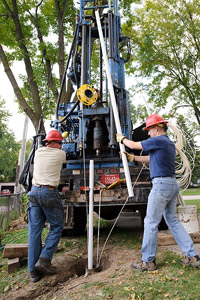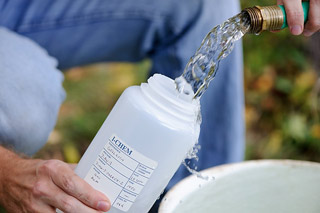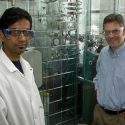Research explores virus movement in Madison groundwater
According to the conventional wisdom, drinking water taken from a deep aquifer protected by a semi-permeable layer of rock should be protected from many contaminants, including viruses.

At, right, Christopher Gellasch, a Ph.D. candidate in geosciences at UW–Madison, lowers a section of pipe with inflatable collars that helps to isolate a small vertical segment of groundwater, on Sept. 28, 2011. The device will collect samples 64 feet deep in a 214-foot monitoring well on the northeast side of Madison, Wis.
Photo: Jeff Miller
But the discovery of virus particles in many deep Madison water wells since 2003 has raised one key question: How do viruses, which should not survive more than two years underground, reach more than 700 feet deep, and penetrate this semi-permeable “aquitard?”
In presentations to the Geological Society of America (Oct. 9-12) meeting in Minneapolis, two Wisconsin scientists will present ongoing research that is narrowing down the transport possibilities.
“When we started looking at this, people said it would be a waste of time,” says Kenneth Bradbury, a hydrogeologist with the Wisconsin Geological and Natural History Survey and University of Wisconsin-Extension. “They said viruses would never get down there, would not remain intact” during the years it would take for them to percolate down through the upper aquifer and finally the aquitard.
After Bradbury, in concert with Mark Borchardt, a microbiologist who is now with the Agricultural Research Service, made that discovery in 2003, the Madison Water Utility raised its chlorination rate to ensure water safety.
But the question remained: How did the viruses travel so deeply and so quickly?
The viruses originate in the human gastrointestinal tract and apparently reach the upper aquifer via leaks in the sanitary sewers, says Christopher Gellasch, a Ph.D. candidate in geosciences at UW–Madison.
In Minneapolis, Gellasch, a lieutenant colonel and environmental science and engineering officer in the U.S. Army, will discuss his ongoing exploration of water movement at a city well in Madison.
Gellasch has made the first discovery of viruses at various depths in the shallow aquifer and in the municipal well. And while examining shallower wells located a few hundred feet away, he has seen disturbances in the water levels when the big city pump operates, indicating a potential connection between the deeper and shallower aquifers.
Now, the challenge is to find the virus pathways.

Since 2003, virus particles have been discovered in many deep Madison wells, and Gellasch, working with the Wisconsin Geological and Natural History Survey and UW-Extension, is researching how such viruses move through underground fractures and a semi-permeable layer of rock to reach the deep aquifer.
Photo: Jeff Miller
“Earlier studies have looked at viruses in both the sewers and the deep wells, but not at the shallow aquifer in between,” Gellasch says. “We knew there were viruses at both ends, but there was no way to test how they moved. These studies will help us identify the potential pathways that allow the viruses to be transported into deep municipal wells that we assumed were protected from them.”
The Eau Claire aquitard is a layer of shale about 25 feet thick that was deposited about 500 million years ago, says Gellasch. Because shale has very low permeability to water, the aquitard was thought to greatly slow groundwater movement into the deep aquifer.
Using a device that isolates a small vertical segment of his monitoring wells for testing, Gellasch has found small fractures that allow an unexpected degree of groundwater movement. Other possible transport pathways for the deep viral contamination include an abandoned (and unknown) deep well, which may penetrate the Eau Claire aquitard and a leak where the municipal well penetrates the aquitard.
Although the scientists have identified virus particles, chloride from water softeners, nitrate, and other chemical constituents typically found in sewage water have been found at discrete depths in the upper aquifer. Although analysis of viruses may be more accurate, tests of water chemistry may be more useful because they are quicker and more economical, Gellasch says.
Leaks in the aquitard could allow other surface contaminants to reach drinking water, says Bradbury, who will discuss other aspects of his ongoing studies at the Minneapolis meeting. “The wells are sampled routinely for many other contaminants, which have rarely been found, maybe because of dilution, or because they tend to bind to the aquifer.”
Because viruses are tiny particles, they can move much more rapidly than bacteria, which are larger and have not been found in the Madison water system, Bradbury says.
Even though the Madison Water Utility chlorinates its drinking water to destroy viruses, some state communities that use deep well water may not do so, and that’s another reason to know more about groundwater movement, says Bradbury.
“This does show that just because you have a deep well beneath an aquitard, it is not necessarily protected from surface contamination,” he says.



